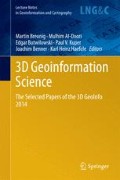Abstract
This paper introduces and formalizes a frame of reference for projective relations in 3D space that can be used to model human visual perception. While in 2D space visibility information can be derived from the concept of collinearity (thus, as ternary relations), in 3D space it can be derived from coplanarity, which calls for quaternary relations. Yet, we can retain ternary relations by anchoring our frame to an ubiquitous reference element: a general sense of vertical direction that, on Earth, can be the expression of gravity force or, in other cases, of the asymmetries of an autonomous agent, either human or robotic, that is, its vertical axis. Based on these observations, the presented frame of reference can be used to model projective and visibility information as ternary relations. Granularity and complexity of the models can be adjusted: we present two differently detailed realizations and discuss possible applications in Geographic Information Systems.
Access this chapter
Tax calculation will be finalised at checkout
Purchases are for personal use only
Notes
- 1.
- 2.
If living in an imaginary 2D space, visibility would follow quite different rules as in the perilous life experience of Flatland characters (Abbott 1884).
- 3.
The acceptance area of an n-ary relation, can be defined as a parametric subset of the relation’s domain, having as a parameter a tuple of n − 1 domain objects.
- 4.
Pyramids, if considering polyhedral objects.
- 5.
Acceptance volumes are the generalization to 3D space of the notion of acceptance areas, discussed in Sect. 2.
References
Abbott EA (1884) Flatland: a romance of many dimensions. Dover Publications Inc., New York (republished in 1992)
Bartie P, Reitsma F, Clementini E, Kingham S (2011) Referring expressions in location based services: the case of the ‘opposite’ relation. In: Advances in conceptual modeling. Recent developments and new directions. LNCS. Springer, pp 231–240
Billen R, Clementini E (2004) A model for ternary projective relations between regions. In: Advances in database technology. LNCS. Springer, pp 537–538
Billen R, Clementini R (2006) Projective relations in a 3D environment. In: Geographic information science. Springer, pp 18–32
Chazelle B (1984) Convex partitions of polyhedra: a lower bound and worst-case optimal algorithm. SIAM J Comput 13(3):488–507
Clementini E, Skiadopoulos S, Billen R, Tarquini F (2010) A reasoning system of ternary projective relations. IEEE Trans Knowl Data Eng 22(2):161–178
Cohn AG, Renz J (2008) Qualitative spatial representation and reasoning. In: Handbook of knowledge representation, foundations of artificial intelligence. Elsevier, pp 551–596
De Felice G, Fogliaroni P, Wallgrün JO (2010) Qualitative reasoning with visibility information for environmental learning. In: Proceedings of the 6th international conference on geographic information science (GIScience 2010)
Fogliaroni P, Wallgrün JO, Clementini E, Tarquini F, Wolter D (2009) A qualitative approach to localization and navigation based on visibility information. In: Proceedings of the 9th international conference on spatial information theory. LNCS. Springer, pp 312–329
Frank AU (1991) Qualitative spatial reasoning with cardinal directions. In: Proceedings of the 7th austrian conference on artificial intelligence. ÖGAI. Springer, pp 157–167
Franklin N, Tversky B (1990) Searching imagined environments. J Exp Psychol Gen 119(1):63
Freksa C (1992) Using orientation information for qualitative spatial reasoning. In: Theories and methods of spatio-temporal reasoning in geographic space, vol 639. LNCS. Springer, pp 162–178
Galton A (1994) Lines of sight. AI Cogn Sci 94:103–113
Hernandez D, Clementini E, Di Felice P (1995) Qualitative distances. In: Spatial information theory a theoretical basis for GIS, vol 988. LNCS. Springer, pp 45–57
Köhler C (2002) The occlusion calculus. Cognitive vision workshop
Randell D, Cui Z, Cohn AG (1992) A spatial logic based on regions and connection. In: Principles of knowledge representation and reasoning: proceedings of the 3rd international conference (KR’92). Morgan Kaufmann, Massachusetts, pp 165–176
Randell D, Witkowski M, Shanahan M (2001) From images to bodies: modelling and exploiting spatial occlusion and motion parallax. In: IJCAI, pp 57–66
Raubal M, Winter S (2002) Enriching way finding instructions with local landmarks. In: Geographic Information Science. LNCS. Springer, pp 243–259
Tarquini F, De Felice G, Fogliaroni P, Clementini E (2007) A qualitative model for visibility relations. In: KI 2007: advances in artificial intelligence, pp 510–513
Tassoni S, Fogliaroni P, Bhatt M, De Felice G (2011) Toward a qualitative model of 3D visibility. 25th international workshop on qualitative reasoning (IJCAI 2011) (position paper)
Author information
Authors and Affiliations
Corresponding author
Editor information
Editors and Affiliations
Rights and permissions
Copyright information
© 2015 Springer International Publishing Switzerland
About this chapter
Cite this chapter
Fogliaroni, P., Clementini, E. (2015). Modeling Visibility in 3D Space: A Qualitative Frame of Reference. In: Breunig, M., Al-Doori, M., Butwilowski, E., Kuper, P., Benner, J., Haefele, K. (eds) 3D Geoinformation Science. Lecture Notes in Geoinformation and Cartography. Springer, Cham. https://doi.org/10.1007/978-3-319-12181-9_15
Download citation
DOI: https://doi.org/10.1007/978-3-319-12181-9_15
Published:
Publisher Name: Springer, Cham
Print ISBN: 978-3-319-12180-2
Online ISBN: 978-3-319-12181-9
eBook Packages: Earth and Environmental ScienceEarth and Environmental Science (R0)

